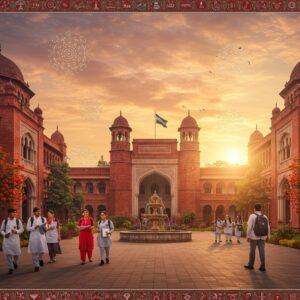
The Indian subcontinent is a land of contrasts, boasting a remarkable variety of landscapes. From the towering Himalayas to the arid Thar Desert, the fertile Indo-Gangetic plains to the lush Western Ghats, this region offers a breathtaking tapestry of natural beauty. This diversity has profoundly shaped the culture, history, and lifestyle of its inhabitants. This article delves into the unique physical features, topography, and landforms that make the Indian subcontinent so captivating.
The Majestic Himalayas
The Himalayas, the world’s highest mountain range, dominate the northern edge of the Indian subcontinent. Stretching across five countries—India, Nepal, Bhutan, Pakistan, and China—these majestic peaks, including Mount Everest, K2, and Kanchenjunga, were formed by the collision of the Indian and Eurasian tectonic plates. This geological event created a haven for unique flora and fauna, such as snow leopards and vibrant rhododendrons.
- Popular destinations like Leh-Ladakh, Shimla, and Darjeeling offer stunning views and opportunities for adventure.
- The Himalayas are also home to sacred sites like Kedarnath and Hemkund Sahib, drawing pilgrims and spiritual seekers. Activities like trekking, mountaineering, and skiing attract adventurers from around the globe.
The Fertile Indo-Gangetic Plains
The Indo-Gangetic Plains, formed by the alluvial deposits of the Indus, Ganges, and Brahmaputra rivers, are among the world’s most fertile regions. This vast expanse supports vital crops like rice, wheat, and sugarcane, sustaining a large population. Major cities like Delhi, Kolkata, and Lahore, steeped in history and culture, lie within these plains.
- This region cradled ancient civilizations, including the Indus Valley Civilization, and witnessed the rise and fall of powerful empires. The plains teem with diverse wildlife, from majestic tigers and elephants to a myriad of bird species.
- While the monsoon rains bring life to the land, the region also grapples with environmental challenges like pollution and the complexities of river management.
The Great Indian Desert (Thar Desert)
Located in northwestern India, primarily in Rajasthan, the Thar Desert presents a stark contrast to the lush plains. Extreme temperatures and scarce rainfall characterize this arid landscape. However, life persists, with camels, desert foxes, and thorny shrubs adapted to these harsh conditions.
- Rajasthan’s vibrant culture shines through its colorful festivals, traditional music and dance, and distinctive attire. Cities like Jaisalmer and Bikaner, with their magnificent forts and palaces, stand as testaments to a rich history.
- Nomadic tribes contribute to the region’s unique cultural tapestry. Tourists are drawn to camel safaris, desert camping, and the mesmerizing beauty of the sand dunes.
The Deccan Plateau
The Deccan Plateau, a vast elevated region in southern India, is of volcanic origin and rich in mineral deposits. Its topography is varied, with hills, valleys, and rivers like the Godavari and Krishna crisscrossing the landscape.
- This region has been the seat of power for significant dynasties, including the Cholas, Vijayanagara, and Marathas. Today, cities like Hyderabad, Pune, and Bangalore blend historical landmarks with modern development.
- The Deccan Plateau supports a range of ecosystems, from tropical forests to grasslands. Wildlife sanctuaries protect the region’s diverse flora and fauna. Hampi, with its ancient ruins, the Ajanta and Ellora Caves, and the biodiversity-rich Western Ghats are popular travel destinations.
The Coastal Plains and Islands
India’s extensive coastline, bordering the Arabian Sea and the Bay of Bengal, is fringed by coastal plains and dotted with islands. Mangroves, coral reefs, and sandy beaches characterize these coastal ecosystems. Major port cities like Mumbai, Chennai, and Karachi play a crucial role in trade and commerce.
- Coastal communities have distinct cuisines, festivals, and traditions, often centered around fishing. The Western and Eastern Ghats, running parallel to the coast, are biodiversity hotspots and act as a protective barrier.
- Goa, Kerala, and the Andaman & Nicobar Islands are popular beach destinations. However, these coastal areas face challenges such as rising sea levels, cyclones, and erosion.
Forests and Wildlife Sanctuaries
The Indian subcontinent is home to a rich variety of forests, from tropical rainforests to deciduous and alpine forests. Biodiversity hotspots like the Western Ghats, Eastern Himalayas, and Sundarbans harbor a wealth of species. These forests play a vital role in maintaining ecological balance and supporting indigenous communities.
- Wildlife sanctuaries like Jim Corbett, Kaziranga, Ranthambore, and Bandipur are dedicated to the conservation of endangered species like tigers and elephants.
- Forests also play a significant role in traditional medicine and the cultural practices of forest-dwelling tribes. Sustainable forest management is crucial in the face of deforestation and other environmental pressures.
Poojn.in: Your Gateway to India’s Cultural Heritage
As you explore the diverse landscapes of the Indian subcontinent, connect with its rich cultural heritage through Poojn.in, India’s leading online store for cultural goods and services. Discover authentic products that reflect the traditions and rituals of this fascinating region. Whether you’re seeking traditional attire, religious artifacts, or items for spiritual practices, Poojn.in offers a wide selection to enhance your cultural experience. Embrace the beauty and diversity of the Indian subcontinent, both in its landscapes and its rich cultural heritage.
- Find traditional clothing and accessories that reflect the diverse styles of different regions.
- Discover religious items and artifacts for your spiritual practices and home altars, including brass statues and puja essentials.
Frequently Asked Questions
What are some must-visit destinations in Northeastern India? Northeastern India offers unique experiences like Brahmaputra River cruises and the Hornbill Festival in Nagaland. Explore the wildlife reserves and tea estates of Assam and Arunachal Pradesh for a taste of nature and culture.
What makes Kashmir a unique destination? Kashmir is known for its stunning alpine meadows and serene beauty.
What are some popular attractions in Goa? Goa’s palm-fringed beaches attract visitors from around the world.
Where can I find authentic Indian cultural goods online? Poojn.in offers a wide range of authentic Indian cultural goods, making it easy to connect with India’s rich heritage from anywhere in the world.
What are some traditional Indian items available on Poojn.in? Tulsi malas, bel malas, and Shiva lingams are just a few examples of the traditional Indian items available on Poojn.in.


